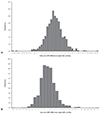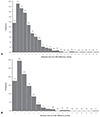1. Clark CE, Campbell JL, Evans PH, Millward A. Prevalence and clinical implications of the inter-arm blood pressure difference: a systematic review. J Hum Hypertens. 2006; 20:923–931.
2. Clark CE, Taylor RS, Shore AC, Ukoumunne OC, Campbell JL. Association of a difference in systolic blood pressure between arms with vascular disease and mortality: a systematic review and meta-analysis. Lancet. 2012; 379:905–914.
3. Weinberg I, Gona P, O’Donnell CJ, Jaff MR, Murabito JM. The systolic blood pressure difference between arms and cardiovascular disease in the Framingham Heart Study. Am J Med. 2014; 127:209–215.
4. Tak YJ, Kim YJ, Lee SY, et al. Association of inter-arm blood pressure difference with atherosclerosis in patients without cardiovascular diseases. J Korean Soc Hypertens. 2013; 19:71–80.
5. Clark CE, Campbell JL, Powell RJ. The interarm blood pressure difference as predictor of cardiovascular events in patients with hypertension in primary care: cohort study. J Hum Hypertens. 2007; 21:633–638.
6. Clark CE, Taylor RS, Shore AC, Campbell JL. The difference in blood pressure readings between arms and survival: primary care cohort study. BMJ. 2012; 344:e1327.
7. Arnett DK, Tang W, Province MA, et al. Interarm differences in seated systolic and diastolic blood pressure: the Hypertension Genetic Epidemiology Network study. J Hypertens. 2005; 23:1141–1147.
8. Clark CE, Steele AM, Taylor RS, Shore AC, Ukoumunne OC, Campbell JL. Interarm blood pressure difference in people with diabetes: measurement and vascular and mortality implications a cohort study. Diabetes Care. 2014; 37:1613–1620.
9. Johansson JK, Puukka PJ, Jula AM. Interarm blood pressure difference and target organ damage in the general population. J Hypertens. 2014; 32:260–266.
10. Su HM, Lin TH, Hsu PC, et al. Association of interarm systolic blood pressure difference with atherosclerosis and left ventricular hypertrophy. PLoS One. 2012; 7:e41173.
11. Kim J, Song TJ, Song D, et al. Interarm blood pressure difference and mortality in patients with acute ischemic stroke. Neurology. 2013; 80:1457–1464.
12. Clark CE, Campbell JL, Powell RJ, Thompson JF. The inter-arm blood pressure difference and peripheral vascular disease: cross-sectional study. Fam Pract. 2007; 24:420–426.
13. Agarwal NK, Agarwal SK. Inter-arm systolic blood pressure difference of 15 mm Hg and its relationship to CRP and other cardiovascular risk markers. History (Lond). 2013; 7:9–12.
14. Kimura A, Hashimoto J, Watabe D, et al. Patient characteristics and factors associated with inter-arm difference of blood pressure measurements in a general population in Ohasama, Japan. J Hypertens. 2004; 22:2277–2283.
15. Pignoli P, Tremoli E, Poli A, Oreste P, Paoletti R. Intimal plus medial thickness of the arterial wall: a direct measurement with ultrasound imaging. Circulation. 1986; 74:1399–1406.
16. Cho HM, Kang DR, Kim HC, Oh SM, Kim BK, Suh I. Association between fibrinogen and carotid atherosclerosis according to smoking status in a Korean male population. Yonsei Med J. 2015; 56:921–927.
17. Petrie JC, O’Brien ET, Littler WA, de Swiet M. Recommendations on blood pressure measurement. [Clin Res Ed]. BMJ. 1986; 293:611–615.
18. Eguchi K, Yacoub M, Jhalani J, Gerin W, Schwartz JE, Pickering TG. Consistency of blood pressure differences between the left and right arms. Arch Intern Med. 2007; 167:388–393.
19. Fonseca-Reyes S, Forsyth-MacQuarrie AM, García de Alba-García JE. Simultaneous blood pressure measurement in both arms in hypertensive and nonhypertensive adult patients. Blood Press Monit. 2012; 17:149–154.
20. Cassidy P, Jones K. A study of inter-arm blood pressure differences in primary care. J Hum Hypertens. 2001; 15:519–522.
21. Maeda S. Blood pressure differences between arms and association of dominant hands with blood pressure differences and carotid atherosclerosis. Blood Press Monit. 2013; 18:133–137.
22. Pickering TG, Hall JE, Appel LJ, et al. Recommendations for blood pressure measurement in humans and experimental animals part: 1: blood pressure measurement in humans: a statement for professionals from the Subcommittee of Professional and Public Education of the American Heart Association Council on High Blood Pressure Research. Hypertension. 2005; 45:142–161.
23. Mancia G, De Backer G, Dominiczak A, et al. 2007 Guidelines for the management of arterial hypertension: The Task Force for the Management of Arterial Hypertension of the European Society of Hypertension (ESH) and of the European Society of Cardiology (ESC). Eur Heart J. 2007; 28:1462–1536.
24. Verberk WJ, Kessels AG, Thien T. Blood pressure measurement method and inter-arm differences: a meta-analysis. Am J Hypertens. 2011; 24:1201–1208.
25. Reeves RA. The rational clinical examination. Does this patient have hypertension? How to measure blood pressure. JAMA. 1995; 273:1211–1218.
26. Wingfield D, Freeman GK, Bulpitt CJ; General Practice Hypertension Study Group (GPHSG). Selective recording in blood pressure readings may increase subsequent mortality. QJM. 2002; 95:571–577.
27. Harrison EG Jr, Roth GM, Hines EA Jr. Bilateral indirect and direct arterial pressures. Circulation. 1960; 22:419–436.
28. Amsterdam B, Amsterdam AL. Disparity in blood pressures in both arms in normals and hypertensives and its clinical significance. N Y State J Med. 1943; 43:2294–2300.
29. Pepys MB. C-reactive protein fifty years on. Lancet. 1981; 1:653–657.










 PDF
PDF ePub
ePub Citation
Citation Print
Print


 XML Download
XML Download